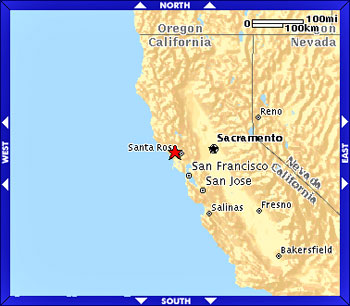|

by Wikipedia
The Free Encyclopedia
from
Wikipedia Website
|
Quotes
"The Bohemian Grove -- which I attend, from time to time -- it is
the most faggy goddamned thing you could ever imagine, with that San
Francisco crowd. I can't shake hands with anybody from San
Francisco."
- President Richard M. Nixon |
Bohemian Grove is a 2700 acre (11 kmē) campground located in Sonoma
County, California belonging to a San Francisco men's fine arts club
known as the Bohemian Club, founded in 1872. The club is built on
four pillars: music, literature, drama and arts, and the club
attracts fine artists, both well known and unknown, as well as those
who appreciate them, some of whom are prominent business leaders and
government officials (notably several U.S. presidents).

click image for
details
The club holds a 2-week long "encampment" during the month of July,
where members and guests gather to share their passion and
appreciations for arts. Dozens of concerts, some scheduled and many
impromptu are held at the grove's amphitheatres and at "camps" every
day, and two original plays, a musical comedy and a drama usually
based on historical events are presented each year. There is also an
on-going art exhibit, and lectures and talks in a wide range of
topics from music history to current political affairs are held.
From the founding of the club, Bohemia's symbol has been an owl. The
owl symbolizes the wisdom of life and companionship that allows
people to survive struggles with the cares of the world. A
forty-foot concrete owl stands at the head of the lake in the Grove
and since 1929 has served as the site of the yearly Cremation of
Care Ceremony. The club's motto, "Weaving Spiders Come Not Here"
taken from A Midsummer Night's Dream, Act 2, Scene 2, signifies that
the club and the grove are not for conducting business, but are for
exchanging friendship and free sharing of common passion, summarized
in the term, "the Bohemian Spirit."
|

Bohemian Grove circa 1909 |
The Cremation of Care was devised in 1893 by a member named
Joseph
D. Redding, a lawyer in New York. The New York Times described the
show in a June 25, 1899 article:
"Great attention was paid to all the
details, and the Druid priests who figured prominently in the show
bore all the insignia of their order on their vestments. Over 500
persons figured in the spectacle, and electric and calcium lights
were used to illuminate the tableaus. There was a symphony orchestra
and a grand chorus. A Druids' altar and sacrificial stone lent an
air of realism to the scenes. Mr. Redding served as High Priest of
Bohemia. Then came a procession of eight Druid priests bearing six
chained captives-- a Gaul, a Celt, a Roman, a barbarian, and two men
from the Far North. Each captive was in costume and each in turn
pleaded his cause before the assembly, but was condemned to death.
Only the Gaul, who represented Bohemia, was able to make a defense
that lifted the sentence from the heads of the captives. A loving
cup was then drunk by Druids, captives, and Bohemians. Mephisto and
a number of devils rushed in and attempted to rescue Care from the
catafalque. The devil made an impassioned address, saying that
goodfellowship was a mockery and that care could not be banished.
Then the Druid leader drove them into the woods with a lighted
torch, which he at once applied to the funeral pyre. After this came
the low jinks, a species of amateur minstrel show. Then the
Bohemians retired to their tents and to such sleep as the wags and
practical jokers of the club permitted them to take."
The ceremony is still played out every year, and is meant "to set
aside the nagging and often unworthy preoccupations which inhibit
openness and warm sympathy for human affairs generally and for works
of artistic and moral creativity in particular".
Some past attendees have included:
Many of the notable
participants have been politically conservative, leading conspiracy
theorists to speculate that the club is actually being used as a
meeting place to secretly determine important public policies.
However, the majority of the members and guests who are targets of
such attacks meet only over the middle weekend of the encampment,
and the club largely remains a haven for artists and art lovers.
|


